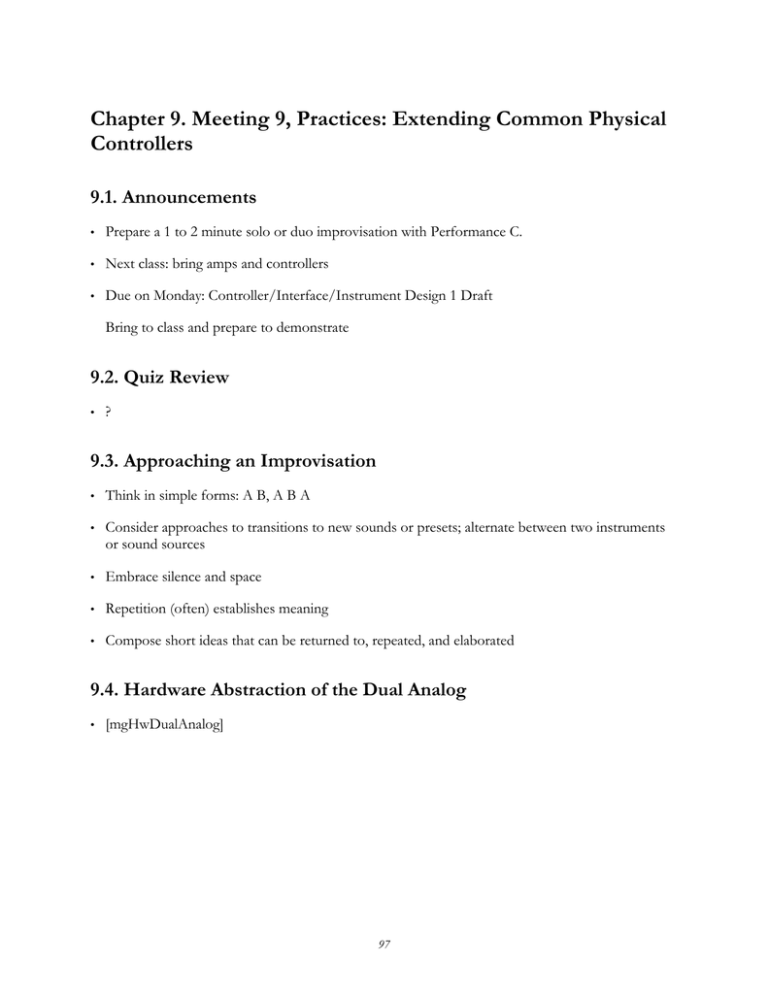
Chapter 9. Meeting 9, Practices: Extending Common Physical
Controllers
9.1. Announcements
•
Prepare a 1 to 2 minute solo or duo improvisation with Performance C.
•
Next class: bring amps and controllers
•
Due on Monday: Controller/Interface/Instrument Design 1 Draft
Bring to class and prepare to demonstrate
9.2. Quiz Review
•
?
9.3. Approaching an Improvisation
•
Think in simple forms: A B, A B A
•
Consider approaches to transitions to new sounds or presets; alternate between two instruments
or sound sources
•
Embrace silence and space
•
Repetition (often) establishes meaning
•
Compose short ideas that can be returned to, repeated, and elaborated
9.4. Hardware Abstraction of the Dual Analog
•
[mgHwDualAnalog]
97
•
Polymorphic control: [mgHwDualAnalogPoly2]
•
Use the appropriate version of [mgHwDualAnalogPoly*] for your platform/controller
combination
Examples: [mgHwDualAnalogPoly2], [mgHwDualAnalogPoly2ChillStream], [mgHwDualAnalogPoly2Joystick], [mgHwDualAnalogPoly2Sixaxis]
98
9.5. VIPP Design Pattern: Synth Square
•
Download: http://www.flexatone.net/transport/instrument01.zip
•
Voice
Independent of any implied hardware or control mapping; no stored parameters
•
Instrument
Assumes basic control data types and ranges; may store parameters, may get parameters from
elsewhere
99
•
Parameters
Parameter storage tied directly to an instrument
•
Performance
Linking a specific hardware interface to one or more instruments; may store mapping parameters,
my control distribution of parameters to instruments
100
9.6. VIPP Design Pattern: Sample Pulse
•
Download: http://www.flexatone.net/transport/instrument02.zip
•
Voice
Independent of any implied hardware or control mapping; no stored parameters
101
•
Instrument
Assumes basic control data types and ranges; may store parameters, may get parameters from
elsewhere
102
•
Parameters
Parameter storage tied directly to an instrument
•
Performance
Linking a specific hardware interface to one or more instruments; may store mapping parameters,
my control distribution of parameters to instruments
103
9.7. Controller/Interface/Instrument Design 1 Draft
•
Can be a new synthesis instrument of some sort
•
Can be an extension, modification, or transformation of existing martingale instruments or
sample instruments
•
Need a model that makes sound with dual analog control: need not have full control
9.8. Common Controllers
•
Many common controllers transmit MIDI
•
Keyboards
•
Combinations of buttons (triggers and toggles) and sliders
•
Touchpads, ribbons, and other continuous controllers
•
Turntables
9.9. MIDI Messages
•
Can be thought of as messages encoded as pairs or triples of data
104
•
Generally, first data element is type of message, second data elements is value
•
Operating system is generally responsible for representing MIDI devices to the software
•
Most modern MIDI devices communicate MIDI over USB
•
Pd MIDI configuration: need to select input device
•
Basic objects that provide MIDI input: notein [notein] and control in [ctlin]
•
Values generally in the range of 0 to 127
105
9.10. MIDI Keyboards
•
Transmits note-on messages received from [notein]
•
Korg NanoKey
© Korg. All rights reserved. This content is excluded from our Creative Commons license.
For more information, see http://ocw.mit.edu/fairuse.
•
Akai LPK 25
© Akai. All rights reserved. This content is excluded from our Creative Commons license.
For more information, see http://ocw.mit.edu/fairuse.
•
[mgHwNanoKey]: abstraction of note-in functionality
106
•
A simple monophonic synth: martingale/instruments/nanoKey
107
9.11. MIDI Sliders and Knobs
•
Up to 128 continuous controllers can be used to send data values between 0 and 127
•
Korg NanoKontrol
© Korg. All rights reserved. This content is excluded from our Creative Commons license.
For more information, see http://ocw.mit.edu/fairuse.
•
[mgHwNanoKontrolContinuous] and [mgHwNanoKontrolDiscrete]
108
9.12. MIDI Pads and Touch Controls
•
Pads were made popular by early drum machines and samplers such as the Linn drum and Akai
MPC
•
Some pad controllers provide aftertouch: dynamic control of pressure on each pad
•
Korg NanoPad: provides velocity sensitive pad controls and XY touch pad
© Korg. All rights reserved. This content is excluded from our Creative Commons license.
For more information, see http://ocw.mit.edu/fairuse.
•
Akai LPD 8
© Akai. All rights reserved. This content is excluded from our Creative Commons license.
For more information, see http://ocw.mit.edu/fairuse.
•
Akai MPD 18
109
© Akai. All rights reserved. This content is excluded from our Creative Commons license.
For more information, see http://ocw.mit.edu/fairuse.
9.13. Turntables and Other Controllers
•
Numerous approaches to making the turntable into a computer controller
•
Rane/Serato scratch live
110
© Rane Corporation. All rights reserved. This content is excluded from our Creative Commons license.
For more information, see http://ocw.mit.edu/fairuse.
9.14. Listening: D-Styles and Kid Koala
•
Creative and musical extensions of the turntable
•
D-Styles, “Felonius Funk,” Scratchology, 2003 •
Kid Koala, “Like irregular Chickens,” Carpal Tunnel Syndrome, 2000 111
9.15. Reading: Perkis, Some Notes on My Electronic Improvisation
Practices
•
Perkis, T. 2009. “Some Notes on My Electronic Improvisation Practices.” In R. T. Dean, ed. The
Oxford Handbook of Computer Music. Oxford University Press, pp. 161-166.
•
Improvising and playing with acoustic musicans led Perkis to adopt a few important strategies:
what are they?
•
What inhibits many players from really knowing how to play their computer-music instruments?
What is gained from really knowing how to play your instrument?
•
Does Perkis directly create musical events, or create macro events, or something in between?
•
What role does the wah-wah perform in Perkis’s setup?
9.16. Reading: Fiebrink, Wang, and Cook, Don't Forget the Laptop
•
Fiebrink, R. and G. Wang, P. Cook. 2007. “Don't Forget the Laptop: Using Native Input
Capabilities for Expressive Musical Control.” Proceedings of the Conference on New Interfaces for Musical
Expression pp. 164-167.
•
What are some novel control options presented in this paper?
•
The authors claim that these approach offer portability: but do they?
•
What are some possible applications of integrated webcams and microphones for musical
control?
112
MIT OpenCourseWare
http://ocw.mit.edu
21M.380 Music and Technology: Live Electronics Performance Practices
Spring 2011
For information about citing these materials or our Terms of Use, visit: http://ocw.mit.edu/terms.




